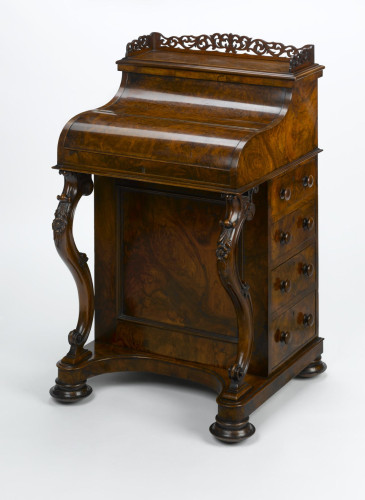6/1946-1
Collection
Furniture
Brief description
Walnut davenport with a fretted gallery, carved and moulded cabriole supports, compressed turned feet with castors, and a writing surface with an inkwell and stationery compartment, made in England in c.1860.
Object name
writing desk
davenport
davenport
Object number
6/1946-1
Location
On Display
Production date
c.1860 (manufactured)
Production place
England (manufactured)
Period
Victorian (1837-1901)
Material
walnut
leather
glass
brass
mahogany
pine
cedar
ceramic
metal
leather
glass
brass
mahogany
pine
cedar
ceramic
metal
Technique
joined
carved
veneered
fret-cut
lined
turned
glued
veneered
nailed
screwed
carved
veneered
fret-cut
lined
turned
glued
veneered
nailed
screwed
Physical description
A walnut Davenport with a fretted ¾ gallery to the top, which is hinged to reveal a fitted stationary compartment. The piano slope encloses two drawers and a sliding writing surface with a hinged leather lined slope on an adjustable easel support and an inkwell and compartments on the right side. It is supported by carved and moulded cabriole supports. The front and back of the base is panelled and there are four drawers to the right side, and sham drawers opposite. It is on a sledge base and compressed turned feet with ceramic castors.
Dimensions
Height: 94cm
Width: 59cm
Depth: 59cm
Width: 59cm
Depth: 59cm
Website keywords
furniture
Label
Label text for 1870 Period Room (Room 6), Geffrye Museum, 2010:
Writing desk
This type of writing desk was known as a Davenport after an English naval captain, who had the first one made, probably for use at sea. Its compact size, useful drawers and sloped writing top made it very suitable for domestic use, and they became popular as a ladies’ desk.
Walnut veneer, c.1860
Writing desk
This type of writing desk was known as a Davenport after an English naval captain, who had the first one made, probably for use at sea. Its compact size, useful drawers and sloped writing top made it very suitable for domestic use, and they became popular as a ladies’ desk.
Walnut veneer, c.1860














